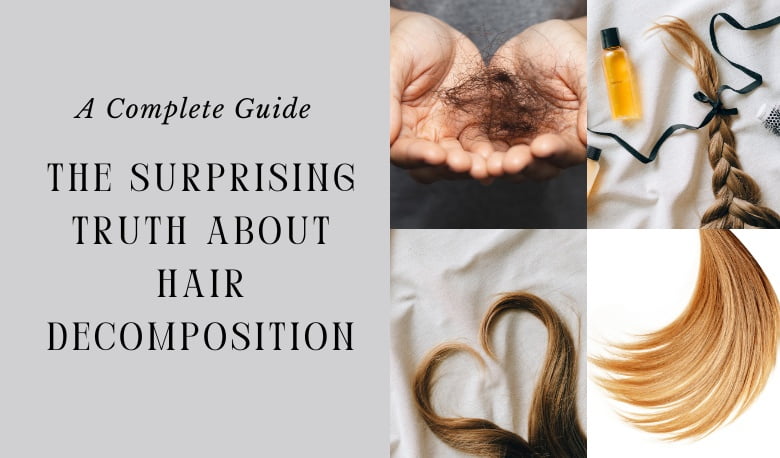Hair seems like such a permanent part of us. It grows, we style it, it might change color over time, but the idea of it truly disappearing is often out of sight and out of mind. Yet, hair decomposition is a fascinating and surprisingly complex process. Whether you’re curious about forensics, concerned about composting, or simply pondering life’s strange cycles, understanding how hair breaks down reveals a lot about the hidden forces of nature.
Hair: Stronger Than You Think
Hair is primarily made of keratin, a remarkably tough protein found in many animal structures like nails, claws, and horns. Keratin’s strength comes from its tightly coiled structure and strong chemical bonds. This is why a single strand of hair can be surprisingly difficult to break. This hardiness is also why hair resists rapid decomposition.

The Stages of Hair Decomposition
While it lasts longer than many other tissues, hair doesn’t remain intact forever. The decomposition process can be generally broken down into a few main stages:
Lag Phase: The Quiet Beginning
Initially, there’s little visible change to the hair. While bacteria and fungi are naturally present in the environment and on the hair itself, their activity is limited in this initial stage. They begin to multiply, but the tough keratin structure of the hair remains largely unaffected.
Active Decay: The Breakdown Begins
Microorganisms begin to truly go to work in this stage, secreting enzymes that break down the keratin in the hair. This weakens the hair’s structure significantly. Visible changes start to occur, including:
- Loss of Elasticity: The hair becomes brittle and less flexible.
- Color Changes: Pigments within the hair may be broken down by microbial action, leading to fading or discoloration.
Fragmentation: Hair Loses its Integrity
The weakened hair reaches a breaking point (literally!) in this stage. It becomes susceptible to fracturing into smaller and smaller pieces. Several factors can contribute to fragmentation:
- Microbial Activity: Continued breakdown of keratin makes the hair even more fragile.
- Environmental Factors: Wind, rain, and physical disturbance from animals can all cause the weakened hair to break apart.
- Insect Activity: Insects like moths and beetles may be attracted to decomposing hair, consuming it or dislodging fragments as they move through it.
Disintegration: The Final Stage
In the disintegration stage, the original structure of the hair is largely lost. Depending on how conducive the environment is to decomposition, this stage can have different outcomes:
- Partial Disintegration: Some small fragments of hair might persist, particularly in less hospitable decomposition environments.
- Complete Disintegration: Over a long enough period and under the right conditions, hair may leave behind only trace amounts of its chemical components – ultimately becoming indistinguishable from the surrounding environment.

Factors That Influence Hair Decomposition
The exact timeline of hair decomposition isn’t set in stone. It depends on a complex interaction of environmental conditions and the specific characteristics of the hair itself:
Environment
- Temperature: Warmth’s Helping Hand Microorganisms responsible for decomposition thrive in warmer temperatures. Their activity increases, leading to faster breakdown of the hair’s keratin. Conversely, cold conditions, like those found in a perpetually frozen environment, will dramatically slow down or even halt the decomposition process.
- Moisture: Finding the Balance Moisture is key, but a delicate balance is needed. Some moisture helps support the microbial populations driving decomposition. However, extremely dry conditions will slow their activity, while overly wet environments can lead to different forms of decay taking over.
- Exposure: Above Ground vs. Below Hair exposed to the elements – sunlight, wind, and fluctuating temperatures – typically decomposes faster than hair buried underground. Burial limits oxygen availability, a crucial component for many of the hair-degrading microbes, and provides insulation that prevents rapid temperature changes.
- Soil pH: An Acidic (or Alkaline) Influence The acidity or alkalinity of the soil surrounding hair can impact decomposition. Extremes of pH can create a harsh environment for microorganisms, hindering their function. Soil that’s closer to neutral generally provides a more favorable environment for the microbes involved in breaking down hair.
Condition of Hair
- Chemical Treatments: Changing the Keratin Dyes, bleaches, perms, and other chemical treatments fundamentally alter the structure of keratin within hair. These alterations can sometimes make the hair more susceptible to breakdown, leading to faster decomposition.
- Presence of Contaminants: Outside Influences Exposure to harsh chemicals, pollutants, or other environmental contaminants can damage the hair. This pre-existing damage can create weak points that accelerate the decomposition process.

Applications: Why Hair Decomposition Matters
Understanding how hair decomposes is surprisingly relevant to various fields:
- Forensic Science: Hair found at crime scenes can be analyzed to provide clues about the timeframe of a death or to help identify an individual.
- Archeology: Analyzing ancient hair samples aids in understanding historical diets, hygiene practices, and even exposure to toxins.
- Composting: While hair is compostable, its slow decomposition means it’s best added in small quantities or shredded to speed the process.
Hair Decomposition: Myths and Facts
Like many natural processes, hair decomposition has spurred some misconceptions:
- Myth: All hair decomposes at the same rate.
- Fact: Factors like hair color, thickness, and the environment greatly affect the timeline.
- Myth: Hair in a coffin never decomposes.
- Fact: With enough time and the right conditions, even hair in a sealed environment will eventually break down.
The enduring power of a simple strand
Despite being technically ‘dead’ tissue, hair holds a surprising amount of information about our lives and even about our environment. The next time you brush your hair or get a trim, remember the fascinating journey those strands may take – one that truly illustrates the surprising and persistent ways nature works to recycle and reintegrate all that we are.

